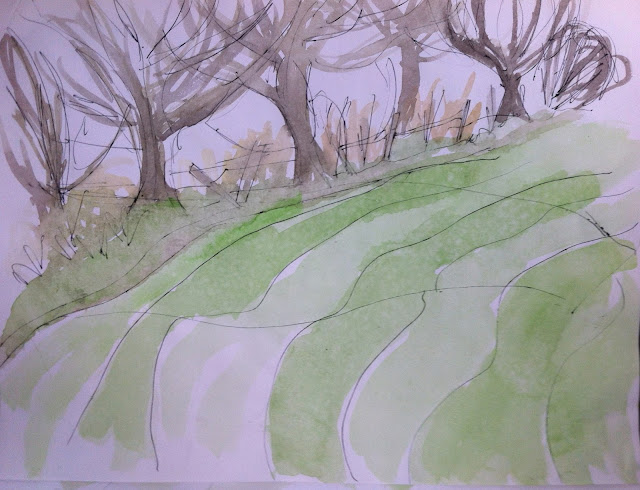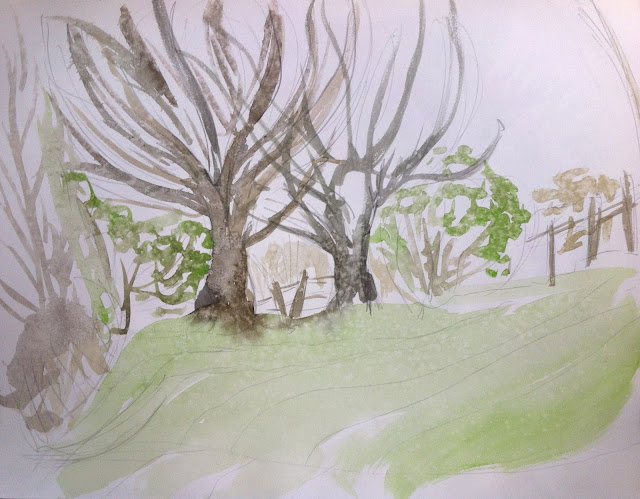Reviewing my posts since I returned to my watercolour studies I can see it feels as though it has been quite a journey, in so few weeks! I do think that my painting with Hyacinth30 has really enabled me to "have fun" nd play with my watercolours while I then focus and concentrate on the exercises. I can see that my artistic attitude seems to have changed since my first delve into this course 12 months ago, I believe this change has happened as I have progressed through Textiles 1: Exploring Ideas as there is far more expectation to work independently in that particular module.
I think its fair to say I have enjoyed these last few weeks as I focus more on completing the watercolour module but I am not sure if landscape painting is for me. I would really appreciate some guidance in my Assignment Feedback around just how much the course "excercises" have to be adhered to and how much scope there is for me to find an alternative approach. I can see that the next assignment continues in the vein of landscape painting and I hope I can find a way of starting to enjoy landscape painting.
Saturday, 4 May 2013
Assignment 3 Landscape Painting from mixed sources
Assignment 3 Landscape Painting from mixed sources
 |
| Winding Path |
Looking at the photograph and back over my sketches I decided that an initial wash on the paper was not going to be appropriate on this occasion as the light that was coming through the gaps in the branches was very bright so I wanted to retain the crispness of the paper, however thinking through my approach to the painting I decided that I would use masking fluid to ensure that the very pale grasses and elements of the stepping stones remained just that, as I knew I would be unable to create such a light tone through watercolour over darker washes! It is interesting the way that the process of brushing the masking fluid onto the paper quite briskly has picked up the texture of the paper, I think I need to remember this effect for future paintings a it seems to really give a natural feathery effect (this can be seen more clearly on the close up photographs below).
The process of sketching my scene before commencing painting really had given me a great grounding to prepare my composition and enable me to really look. I found that the sketches drew my eye to the arrangement of the stepping stones which someone has laid for when the path is really muddy. In my first sketch the stepping stones dominated and were pretty much central, however as I looked and looked again the stepping stones moved to the correct position of left of centre.
It was really one of my aims with this painting not to fall into what I see as a personal trap of loosing the life of my painting when I spend longer on it. Reviewing the painting in light of the preparatory sketches and comparing them with my previous "laboured over" paintings I am reasonably happy that I am starting to move in the right direction. I think the decision not to commence with any kind of wash was the correct one as the watercolours have remained fairly crisp on the page despite the layers required with the tree branches to give the feeling of depth and distance.
Comparing the painting back and forth to the photograph I suppose it could have stood for some more darker tones to be added, however I had decided my approach to this painting was not going to be to aim to "copy" the photograph, but to create a painting that is based on the photograph and sketches.
 |
| Winding Path - Close Up |
Comparing the painting back and forth to the photograph I suppose it could have stood for some more darker tones to be added, however I had decided my approach to this painting was not going to be to aim to "copy" the photograph, but to create a painting that is based on the photograph and sketches.
 |
| Winding Path - Close Up |
 |
| Winding Path - reference photograph |
Wednesday, 1 May 2013
Part 3, Project 3, Exercise: Preparatory Sketches
I decided to use the same location as the previous exercise as it is so local however I decided to turn around from where was was sitting on the previous occasion and to work on the path leading to the field. these are my sketches using different portable media:-
A Line Study
A Colour Study
 |
| Preparatory Sketches - Pencil Study |
 |
| Preparatory Sketches Chalk Pastel Study |
 |
| Preparatory Sketches - Coloured Pencil Study |
 |
| Preparatory Sketches Charcoal Study |
 |
| Preparatory Sketches - Watercolour Pencil Study |
A Line Study
I really enjoyed the process of creating a line study for this exercise. It felt as though it was stripping back the processes of creating shape and form in my paintings. the temptation to shade with cross hatching was great, but I think I managed not to do too much shading!
 |
| Preparatory Sketches - A Line Study |
I enjoyed the approach of working freely on the paper and simply focussing on colour, the watercolour study was very blurred and again I worked quite quickly to establish a colour range for reference later. Like the previous exercises where I worked in the field through the colour study I noticed that there were pink tones which at the first glance at a scene would not be immediately obvious.
 |
| Preparatory Sketches - A Colour Study |
Comparison of Painting from a photograph and Painting on the spot
If I am completely honest I preferred painting from a photograph. Painting on the spot, specifically for this exercise felt like a chore to be got through. In the sunshine of the York Minster garden it was enjoyable and relaxing, in the local drizzle it felt much less so!
I do however think it was a worthwhile thing to do, it allowed me to highlight what specifically I need to be considering when painting a landscape, namely I don't have to paint everything I see and I can narrow my view and exclude certain elements if I do not feel they contribute positively to my composition. I think it is hard to say which exercise was more "valuable" to me, I feel that both exercises combined gave me the learning points that I referred to above.
I do however think it was a worthwhile thing to do, it allowed me to highlight what specifically I need to be considering when painting a landscape, namely I don't have to paint everything I see and I can narrow my view and exclude certain elements if I do not feel they contribute positively to my composition. I think it is hard to say which exercise was more "valuable" to me, I feel that both exercises combined gave me the learning points that I referred to above.
Part 3, Project 3, Exercise: Painting on the spot
 |
| Exercise: Painting on the spot Painting 1 |
Part 3, Project 3, Exercise: Painting from a photograph
 |
| Final Choice for printing on A4 |
 |
| Other photographs at the same location |
 |
| Other photographs at the same location |
I am rally trying to apply learning from previous exercises as I progress through this course rather than view the exercises in isolation, so before commencing painting from the photograph I decided to carry out an experimental sketch beforehand in my sketchbook.
 |
| Sketch prior to working on "Painting from a photograph" |
I then worked on my painting using the photograph an my sketchbook as reference, here s the completed painting:-
 |
| Final Painting - Painting from a photograph |
The colours are more true to the photograph in "real life" than they are on this photograph, which seems a a difficult concept to explain but I do not want to start adjusting the colours in my photographs simply to make them look truer on my learning log/blog!
This study does not look like a study made outdoors, looking back at my other paintings made outdoors I think this is because I have taken my time in painting it, I have allowed the various colour washes to dry between washes, in fact I have used this drying effect deliberately to create definition between the lines in the
grass and to create the feeling of distance and depth in the trees.
The completed painting does resemble the photograph, in my head this says this is a success, however emotionally I question whether this is actually what I am trying to achieve. My painting with hyacinth30 http://hyacinth30.blogspot.co.uk/ became much more implicit of the hyacinth than representational, and I viewed this more abstract approach as success, rather than creating meticulous reproductions of the hyacinth at each attempt. I think I am approaching a point in this module where I need to decide whether to translate the exercises literally and follow the instructions to the letter, or whether to try to give a more emotional response to the required exercise and tasks.
The problems with painting from a photograph of a scene which I have "seen" mean that I am not just referring to the photograph for content but also considering the weather conditions, the tone of the light, the temperature and the "essence" of the place, all of which are very difficult to re-capture in a painting. I don't think I necessarily needed any more information to make this picture a success but I think this painting was more about not trying to include everything in the painting rather than trying to include everything on the photograph (which was tempting!).
I think the main difference in approach for this exercise was ensuring I completed a preliminary sketch beforehand, I think this was instrumental in me having a bit more confidence to select a part of the scene rather than feel I had to recreate the entire image.
Subscribe to:
Posts (Atom)
